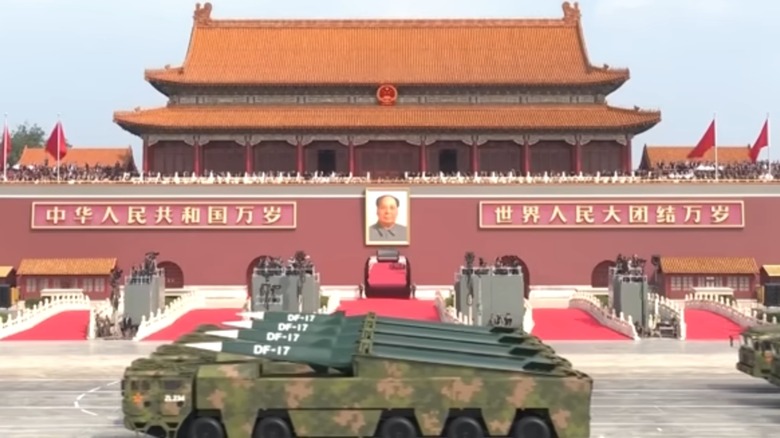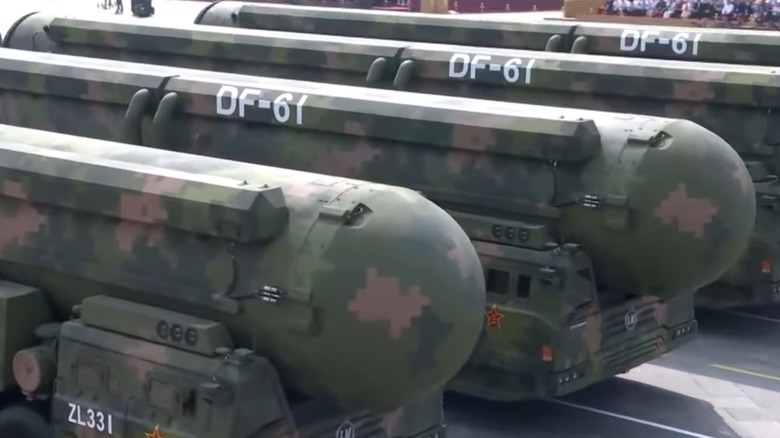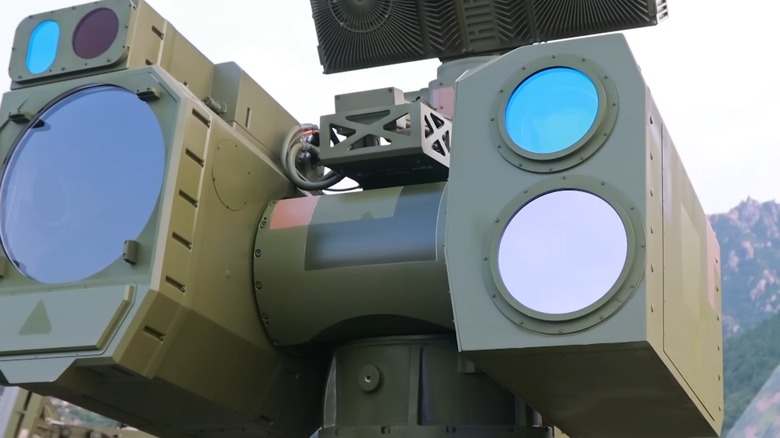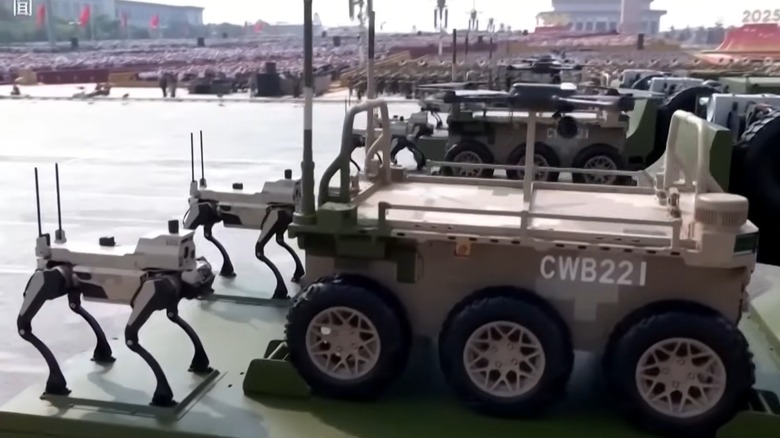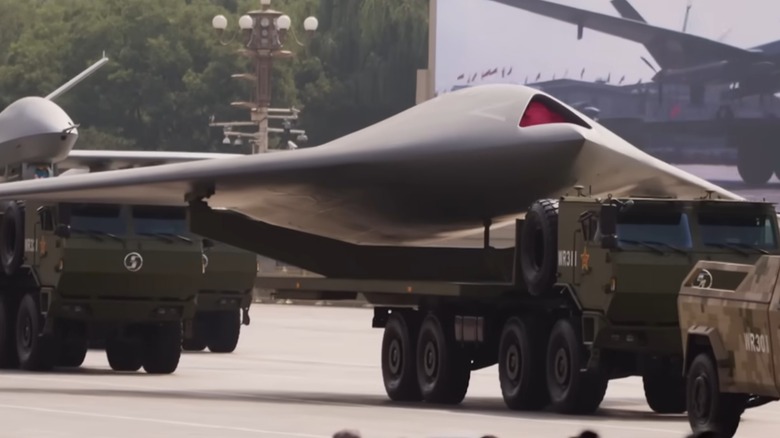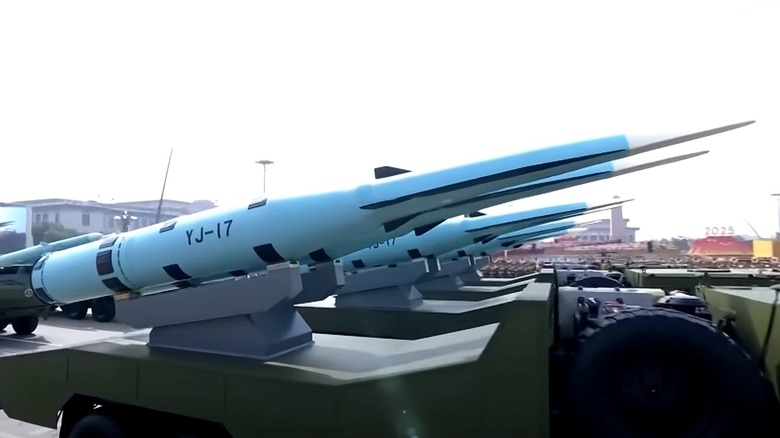Robot Wolves & More: Every Weapon China Displayed At Its Military Parade
While it's not typically customary in the United States, nations like the People's Republic of China, the Democratic People's Republic of Korea (DPRK), and the Russian Federation enjoy showing off their might in massive military parades. China held one such event, and in attendance were Russian President Vladimir Putin and DPRK leader Kim Jong Un, both of whom were guests of honor of Chinese President Xi Jinping. The parade, conducted on September 3, 2025, commemorated the 80th anniversary of the end of World War II in the Pacific.
China didn't hold back in displaying its new and improved weapon systems, including naval drones, intercontinental ballistic missiles (ICBMs), robot wolves, and much more. Video and still images from the parade show a variety of weapons, all laid out in perfect synchrony as they traveled down Chang'an Avenue in Beijing, China. Some of the weapons were previously known to the West, while many others were either rumored or unknown to have been in development.
Naturally, many in the West kept their eyes peeled at everything China unveiled, as it's not uncommon to develop similar systems or potential countermeasures. Of particular note are China's hypersonic missiles. Because China can potentially use these weapons to sink American aircraft carriers, defense officials likely paid rapt attention. While China displayed its might, it should be noted that the nation's military claims can often be taken with a grain of salt. Some capabilities might be overstated or erroneous, though it appears China is advancing quickly with its 21st-century weapons.
China's new DF-61 ICBM was finally revealed
Of all the weapons China displayed at the 80th anniversary victory parade, the Dongfeng-61 is the most destructive. The DF-61 is a new ICBM that was paraded atop 16-wheel HTF5980 Transporter erector Launchers (TEL), indicating that it's mobile and easily transportable over long distances. While China didn't provide a handy brochure with the missile's capabilities, Western analysts believe they have some information gained through comparative analysis of existing weapons.
The DF-61 is the successor to the DF-41, and is a next-generation upgrade to China's nuclear inventory. It's believed that the DF-41 can carry up to ten multiple independently-targetable reentry vehicle (MIRV) warheads. For comparison, the U.S.'s comparable ICBM, the Minuteman III, carries only one, following the New START treaty of which China is not a signatory. It's believed that the DF-61's range is comparable to the DF-41, suggesting it can reach targets 7,500 miles from its launch site. The DL-61 was hardly the only massive missile displayed at the parade.
The JL-3 submarine-launched ballistic missile (SLBM) was displayed alongside China's first air-launched ballistic missile (ALBM). The JL-1 can be fired from airborne assets, extending its range considerably. While the missile's range is unknown, it appears to be a variant of the DF-21, which has a range of 1,336 miles. China is building its nuclear stockpile with a goal of reaching 1,500 warheads by 2035. Additionally, showing sea, land, and air-based nuclear-capable missiles revealed China's nuclear triad for the first time.
The LY-1 High-Power Laser looks formidable
An interesting area that China and many other nations are exploring is laser-based offensive and defensive systems. China revealed two during its parade, with the LY-1 standing out. The LY-1 was displayed atop a series of eight-wheeled trucks, suggesting it could be utilized on land, but it's designed for naval vessels. While it was on full display, there isn't too much known about the LY-1's specs yet.
High-powered lasers use a great deal of energy, which is why ships are excellent platforms for their use, but it's possible China has more than one use ascribed to the LY-1. The system boasts a large circular aperture alongside various sensors, but there's no telling what its power rating might be. In the U.S., military-grade lasers for ship-based systems are at the 60-kilowatt range, so it's possible the LY-1 is comparable. Should China utilize the LY-1 in the same manner as American systems, it could potentially damage or destroy drones or missiles.
Another defensive laser system shown at the parade is intended for ground vehicles. An unnamed truck-mounted weapon system was touted by state media as a high-energy anti-drone device. Stopping drones has become a crucial defensive measure for any military. Because of the threat, using comparatively cheap lasers to shoot them down in lieu of costly missiles or other systems makes a lot of sense. China is clearly on board with that thinking, which mirrors developments in many nations around the world.
Robot Wolves?
Another key standout at China's parade was the so-called "Robot Wolves." These quadrupedal drone systems were affixed to the back of trucks alongside a six-wheeled quadcopter-carrying drone. Since the Robot Wolves didn't move, their capabilities remain unknown; however, there are comparable pieces of equipment in the West. The now-discontinued Boston Dynamics' BigDog had demonstrated numerous capabilities, including the ability to carry heavy loads, thereby relieving soldiers of this burden.
China's Robot Wolves appear similar, though with a smaller form factor and different leg orientation. China had previously shown its gun-toting Robot Wolves on state TV, each of which boasted large sensor packages on its back. China's state television indicated they could fire precisely-aimed shots while in rough terrain. If this is true, it represents a lethal and significant upgrade to ground-based drones, which have seen a great deal of use in the Russo-Ukrainian War.
China had previously revealed its Robot Wolves at an air show, so while they weren't new to the West, their inclusion in the victory parade suggests the nation is proud of these systems. If they're anything like similar drones in the West, they can potentially carry up to 22 pounds, function for around three+ hours of continuous walking or 20+ hours on standby. They can likely be utilized for support, reconnaissance, and offensive means. China is hardly the only country interested in these types of land-based drones, so further developments are likely to bear fruit across the world's developed nations.
Drones, drones, and more drones
Unsurprisingly, China's parade included a plethora of new drones of all sizes, shapes, and capabilities. The future of warfare is drone combat, and China is throwing as much money, research, and development into this area as other nations. During the parade, a variety of ground, sea, and air-based drones were displayed, some of which looked eerily similar to those developed in some Western nations. An unnamed helicopter drone was seen on the ground that bore more than a passing resemblance to the AVIC AR-2000.
China has been stealing and copying Western designs for decades, so this is unsurprising. The helicopter drone appears to be intended for shipboard operations while the GJ-11/21 flying wing combat drone is likely designed for carrier-based operations. These could potentially fly as robotic wingmen drones or conduct combat operations independently, mirroring the U.S. Air Force's Collaborative Combat Aircraft program. Pairing drones with crewed aircraft could increase lethality while expanding defensive capabilities, reducing the threat to human operators.
A variety of naval drones were displayed as well, including the HSU100 uncrewed underwater vehicle (UUV). This was followed by a small surface drone and the AJX-002 UUV. Their capabilities remain unknown to the West, but they could potentially be used for intelligence, surveillance, and reconnaissance (ISR). It's likely they also boast offensive and defensive capabilities. Of significant note was the unnamed stealth-capable, tailless uncrewed combat aerial vehicle (UCAV), which has the potential to exponentially increase China's airborne lethality and stealth operations.
Conventional weapon systems alongside hypersonic ship-killers
One of the most significant threats to China's potential enemies is its growing supply of hypersonic missiles, and it appears to have more than a few. A missile is classified as hypersonic if it exceeds Mach 5 (3,836 mph). China is a leading nation in the development of this technology, although Russia has surpassed all other countries and was the first to use hypersonic missiles in combat. The YJ-15, YJ-17, YJ-19, and YJ-20 were shown. All of these weapons are designed as anti-ship missiles that are likely hypersonic or high-supersonic.
China's hypersonic missiles are concerning to the West, forcing nations like the U.S. to develop their own as well as potential defenses. The parade wasn't solely focused on nuclear or strategic weapon systems, as many conventional pieces of equipment were also revealed. These include the AMB012 torpedo, the AJC015 rocket-launched torpedo, and the AQA010 heavyweight torpedo. It's clear China is concerned about naval vessels, which makes sense given the U.S.'s strong force of 11 nuclear-powered aircraft carriers.
China also displayed a new Type-100 tank and Type-100 fighting vehicle. The main battle tank is China's third-generation (possibly fourth), based on the Soviet-era T-72 chassis, but it's considerably more advanced. State media described it as being intelligent and capable of coordinated combat operations. It looked to have a remote-controlled turret above its main gun. State media also touted its protective capabilities and augmented reality system, though this was not elaborated on or further explained.
